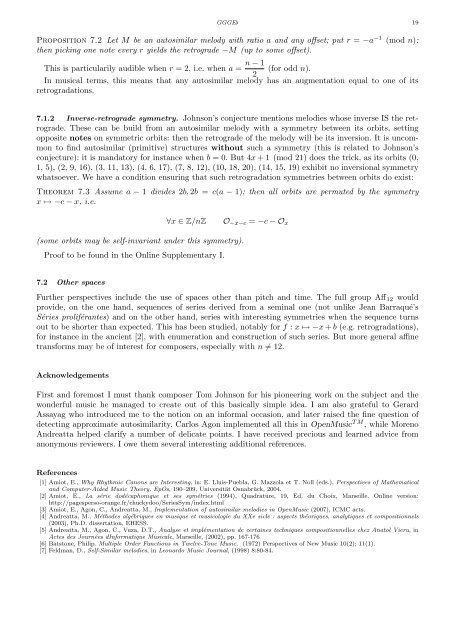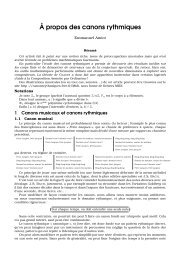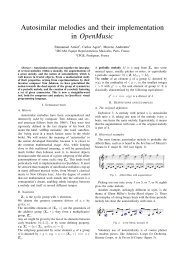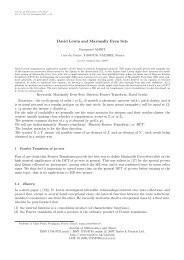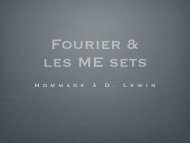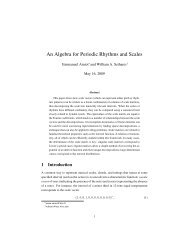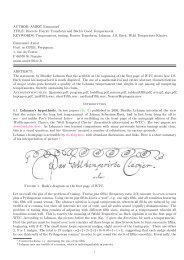Emmanuel Amiot Modèles algébriques et algorithmes pour la ...
Emmanuel Amiot Modèles algébriques et algorithmes pour la ...
Emmanuel Amiot Modèles algébriques et algorithmes pour la ...
Create successful ePaper yourself
Turn your PDF publications into a flip-book with our unique Google optimized e-Paper software.
GGGE♭ 19<br />
Proposition 7.2 L<strong>et</strong> M be an autosimi<strong>la</strong>r melody with ratio a and any offs<strong>et</strong>; put r = −a −1 (mod n);<br />
then picking one note every r yields the r<strong>et</strong>rograde −M (up to some offs<strong>et</strong>).<br />
n − 1<br />
This is particu<strong>la</strong>rily audible when r = 2, i.e. when a = (for odd n).<br />
2<br />
In musical terms, this means that any autosimi<strong>la</strong>r melody has an augmentation equal to one of its<br />
r<strong>et</strong>rogradations.<br />
7.1.2 Inverse-r<strong>et</strong>rograde symm<strong>et</strong>ry. Johnson’s conjecture mentions melodies whose inverse IS the r<strong>et</strong>rograde.<br />
These can be build from an autosimi<strong>la</strong>r melody with a symm<strong>et</strong>ry b<strong>et</strong>ween its orbits, s<strong>et</strong>ting<br />
opposite notes on symm<strong>et</strong>ric orbits: then the r<strong>et</strong>rograde of the melody will be its inversion. It is uncommon<br />
to find autosimi<strong>la</strong>r (primitive) structures without such a symm<strong>et</strong>ry (this is re<strong>la</strong>ted to Johnson’s<br />
conjecture): it is mandatory for instance when b = 0. But 4x + 1 (mod 21) does the trick, as its orbits (0,<br />
1, 5), (2, 9, 16), (3, 11, 13), (4, 6, 17), (7, 8, 12), (10, 18, 20), (14, 15, 19) exhibit no inversional symm<strong>et</strong>ry<br />
whatsoever. We have a condition ensuring that such r<strong>et</strong>rogradation symm<strong>et</strong>ries b<strong>et</strong>ween orbits do exist:<br />
Theorem 7.3 Assume a − 1 divides 2b, 2b = c(a − 1); then all orbits are permuted by the symm<strong>et</strong>ry<br />
x ↦→ −c − x, i.e.<br />
∀x ∈ Z/nZ O−x−c = −c − Ox<br />
(some orbits may be self-invariant under this symm<strong>et</strong>ry).<br />
Proof to be found in the Online Supplementary I.<br />
7.2 Other spaces<br />
Further perspectives include the use of spaces other than pitch and time. The full group Aff12 would<br />
provide, on the one hand, sequences of series derived from a seminal one (not unlike Jean Barraqué’s<br />
Séries proliférantes) and on the other hand, series with interesting symm<strong>et</strong>ries when the sequence turns<br />
out to be shorter than expected. This has been studied, notably for f : x ↦→ −x + b (e.g. r<strong>et</strong>rogradations),<br />
for instance in the ancient [2], with enumeration and construction of such series. But more general affine<br />
transforms may be of interest for composers, especially with n = 12.<br />
Acknowledgements<br />
First and foremost I must thank composer Tom Johnson for his pioneering work on the subject and the<br />
wonderful music he managed to create out of this basically simple idea. I am also grateful to Gerard<br />
Assayag who introduced me to the notion on an informal occasion, and <strong>la</strong>ter raised the fine question of<br />
d<strong>et</strong>ecting approximate autosimi<strong>la</strong>rity. Carlos Agon implemented all this in OpenMusic T M , while Moreno<br />
Andreatta helped c<strong>la</strong>rify a number of delicate points. I have received precious and learned advice from<br />
anonymous reviewers. I owe them several interesting additional references.<br />
References<br />
[1] <strong>Amiot</strong>, E., Why Rhythmic Canons are Interesting, in: E. Lluis-Pueb<strong>la</strong>, G. Mazzo<strong>la</strong> <strong>et</strong> T. Noll (eds.), Perspectives of Mathematical<br />
and Computer-Aided Music Theory, EpOs, 190–209, Universität Osnabrück, 2004.<br />
[2] <strong>Amiot</strong>, E., La série dodécaphonique <strong>et</strong> ses symétries (1994), Quadrature, 19, Ed. du Choix, Marseille. Online version:<br />
http://pagesperso-orange.fr/chuckydoo/SeriesSym/index.html<br />
[3] <strong>Amiot</strong>, E., Agon, C., Andreatta, M., Implementation of autosimi<strong>la</strong>r melodies in OpenMusic (2007), ICMC acts.<br />
[4] Andreatta, M., Méthodes <strong>algébriques</strong> en musique <strong>et</strong> musicologie du XXe sicle : aspects théoriques, analytiques <strong>et</strong> compositionnels<br />
(2003), Ph.D. dissertation, EHESS.<br />
[5] Andreatta, M., Agon, C., Vuza, D.T., Analyse <strong>et</strong> implémentation de certaines techniques compositionnelles chez Anatol Vieru, in<br />
Actes des Journées dInformatique Musicale, Marseille, (2002), pp. 167-176<br />
[6] Batstone, Philip. Multiple Order Functions in Twelve-Tone Music. (1972) Perspectives of New Music 10(2); 11(1).<br />
[7] Feldman, D., Self-Simi<strong>la</strong>r melodies, in Leonardo Music Journal, (1998) 8:80-84.


